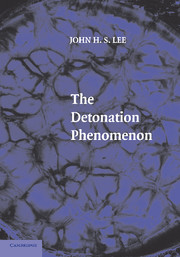Book contents
- Frontmatter
- Contents
- Preface
- 1 INTRODUCTION
- 2 GASDYNAMIC THEORY OF DETONATIONS AND DEFLAGRATIONS
- 3 DYNAMICS OF DETONATION PRODUCTS
- 4 LAMINAR STRUCTURE OF DETONATIONS
- 5 UNSTABLE DETONATIONS: NUMERICAL DESCRIPTION
- 6 UNSTABLE DETONATIONS: EXPERIMENTAL OBSERVATIONS
- 7 INFLUENCE OF BOUNDARY CONDITIONS
- 8 DEFLAGRATION-TO-DETONATION TRANSITION
- 9 DIRECT INITIATION OF DETONATIONS
- Epilogue
- Index
3 - DYNAMICS OF DETONATION PRODUCTS
Published online by Cambridge University Press: 06 July 2010
- Frontmatter
- Contents
- Preface
- 1 INTRODUCTION
- 2 GASDYNAMIC THEORY OF DETONATIONS AND DEFLAGRATIONS
- 3 DYNAMICS OF DETONATION PRODUCTS
- 4 LAMINAR STRUCTURE OF DETONATIONS
- 5 UNSTABLE DETONATIONS: NUMERICAL DESCRIPTION
- 6 UNSTABLE DETONATIONS: EXPERIMENTAL OBSERVATIONS
- 7 INFLUENCE OF BOUNDARY CONDITIONS
- 8 DEFLAGRATION-TO-DETONATION TRANSITION
- 9 DIRECT INITIATION OF DETONATIONS
- Epilogue
- Index
Summary
INTRODUCTION
A solution to the steady conservation equations across a detonation wave alone does not guarantee that a steady CJ wave can be realized experimentally. In the previous chapter, physical arguments (e.g., stability and entropy considerations) were presented in an attempt to rule out certain solutions of the conservation equations. However, solutions to the conservation equations for detonations must also be compatible with the rear boundary conditions in the combustion products, as in the case of deflagrations. For strong detonations where the flow downstream is subsonic, disturbances from the rear can propagate upstream to influence the wave, and thus it is clear that the solution must satisfy the rear boundary condition. Even for a Chapman–Jouguet (CJ) detonation, where the CJ criterion permits the solution of the conservation equations to be determined independently of the downstream flow of the combustion products, the solution for the nonsteady expansion of the products must nevertheless satisfy the sonic condition at the CJ plane. However, this is not always the case. For example, for diverging cylindrical and spherical detonations, the sonic condition behind a CJ detonation results in a singularity, which leads to the question of whether or not diverging CJ detonations can exist. Thus, the existence of a solution to the steady conservation laws also depends on the compatibility of the solution with the dynamics of the combustion products behind the wave.
- Type
- Chapter
- Information
- The Detonation Phenomenon , pp. 53 - 72Publisher: Cambridge University PressPrint publication year: 2008



